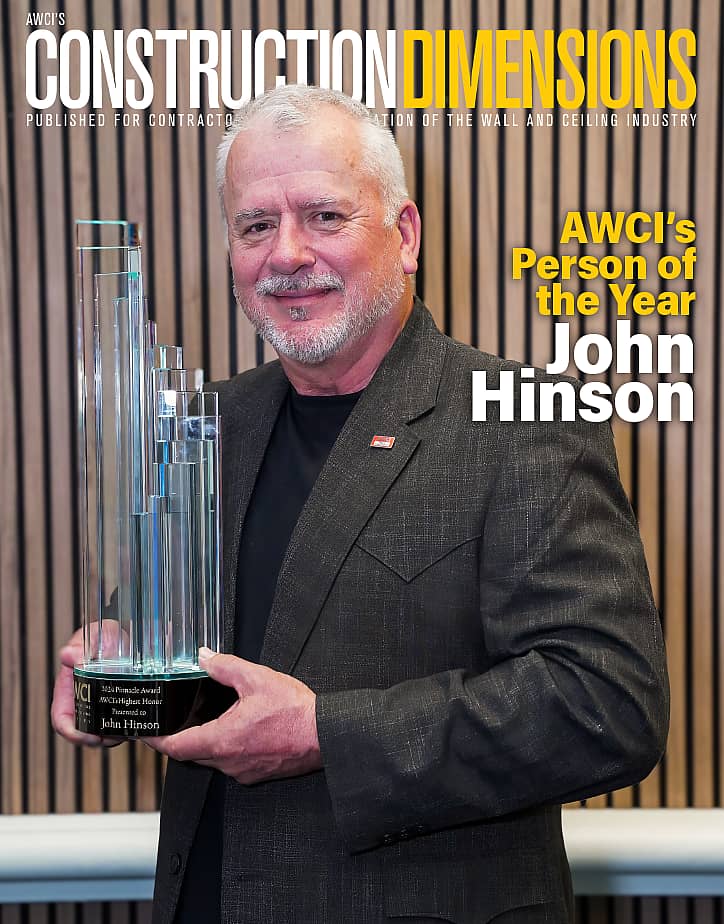Disruption is underway in wall and ceiling construction whether we like it or not.
This period of time reminds me of the 1970s, when AWCI members were adding drywall and steel framing to their product and service offerings. Plaster and drywall were consolidating into a single industry represented by two wall-and-ceiling associations. Those associations—the Gypsum Drywall Contractors International and the international association of the Wall & Ceiling Industry—merged and became what we now know as AWCI.
On May 15, 1976, John W. Thomson Jr., iaWCC president emeritus, in a hotel room in Reston, Va., told the two groups to sign their merger papers. “I suggest we get on with it,” he said.
Who, What and Where
I suggest that three forces will influence our industry significantly in the next 10 years: the Who, What and Where. Who’s working for our firms? What is in, How safely are they working? And where: Where do they work?
Who: Four of 10 will be new to the industry. According to the National Center for Construction Education & Research, 29% of the current construction workforce will retire by 2026, and 41% of the workforce will retire by 2031. Are you preparing for that future, NCCER asks?
This hits our industry hard because much of our skilled labor has come from abroad. And that workforce is down to its lowest levels in a decade, according to Pew Research Center.
Lawful immigrant workers represent 20% of all drywall installers, ceiling tile installers and tapers, Pew Research says. Unauthorized immigrant workers represent 4.8% of the total labor force—but 17.7% of construction laborers and 30% of all drywall installers, ceiling tile installers and tapers, according to the U.S. Census Bureau.
There’s some work to do in Washington on this issue, isn’t there?
What: Safety is a really big deal. Safety always was a big deal, but the pandemic made it more so.
The U.S. Department of Labor’s Occupational Safety and Health Administration requires most construction employers to keep OSHA injury and illness records, and has issued recommendations on personal protective equipment. Some states turned those recommendations into requirements, and many firms are rewriting their safety plans to include COVID-19 response protocols.
Greg Eckstrom, senior vice president at California Drywall in California, says he started working on COVID-related policies and provisions in December 2020 and didn’t come up for air until late February 2021.
Where: Off site. A McKinsey & Company report says a large share of the construction value chain is moving from job sites to off-site prefabrication facilities.
The response? Industry firms are investing heavily in CNC laser and plasma cutting machines, automated cold-formed steel roll-forming machines and building information modeling technologies.
“We easily transfer data from BIM and other models to our automated machinery allowing for mass production of standard and customized items,” Eckstrom says.
The key word in Eckstrom’s comment is standardization.
“Off-site manufacturing and pre-fabrication has the potential to enable standardization and drastically improve productivity in construction,” Eckstrom says.
By using standardized processes to build walls and other components of buildings, California Drywall is producing, panels, modules and kits and shipping them to job sites ready to assemble in place.
Efforts to standardize the industry’s products has been underway for some time. Some advocate having an industry library or database of standard wall types—each wall represented by specific wallboard types and thicknesses, precise cold-formed metal stud widths, gauges and spacing, and other characteristics, such as insulation type and soundproofing requirements. The industry wants uniformity.
Rather than wait for that to happen at an industry-wide level, California Drywall is moving forward on its own.
“We are building our own standardized library of components and sub-systems that can be produced and assembled according to client’s project requirements,” Eckstrom says.
It makes sense. The walls needed in Google or Stanford University projects, where California Drywall works regularly, may be very different than the walls required of New York City projects.
When? Now
It’s time to get moving, people. These three disrupters are certainly not the only disrupters out there, but they are part of a new and permanent way of doing business.
What should we do? Do today, what Thomson said in 1976: “Get on with it.”
Mark L. Johnson writes for the wall and ceiling industry. He can be reached via linkedin.com/in/markjohnsoncommunications.



